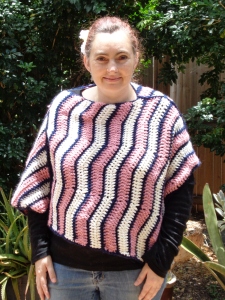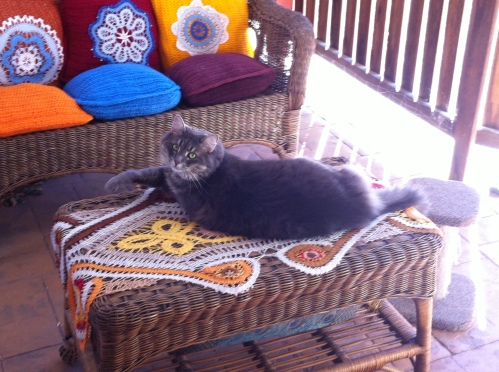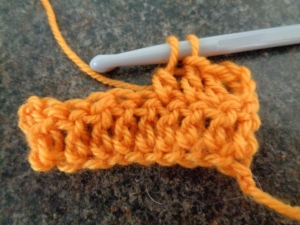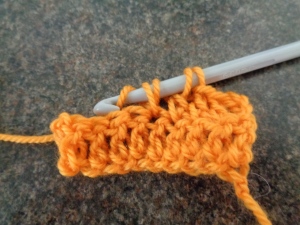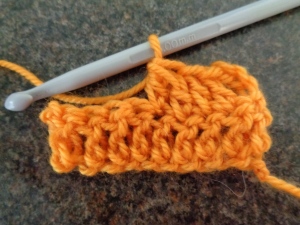Hi Everyone,
It’s Typsy here! Prrrrr to you all.

I thought I’d help Mimi out by doing the next post. Today I’m going to explain about tension squares and show you how to make them.
Many people are so excited about starting their new project that they skip or forget to do a tension square first. Oh O. The end result is that their new item is bigger or smaller than the pattern said it would be. You can get away with this when making cushions or rugs – but if you are making an item of clothing you want it to be the RIGHT size, right?
So this is what you do
1. Check the pattern for the gauge details
The gauge has 2 parts. First is the pattern of what stitches to do. And the second is the measurements for how big the stitches should be.
For our example we are going to do the following:
Pattern – alternating rows of hdcs (half double crochets – American system) with trs (triple crochets – American system).
This is how this pattern looks

And the pattern specifies
10cm/ 4 inches wide = 14 stitches, 10cm/ 4 inches high = 8.5 rows
Also important is the hook size and recommended yarn, which in this pattern is hook sized 3.5mm and 4ply cotton
2. Crochet a square
It is fairly standard that a gauge will tell you what length and width to make the square, but it is better to make the square bigger than this because edges and the first row can be misleading if your tension isn’t 100% stable… mine never is…
So for a 10cm/ 4 inch make a square that is 15- 20 cm/ 5-6 inches in size. The width is more important than the height because it can’t be easily fixed once the garment is underway. For this reason I do a square that is 20 cm wide and 15 cm tall.
In this example I am also using a different type of yarn than the recommended cotton – still the same size (equivalent to 4ply) but a different texture.
And here is my first square.

3. Assess the square
Now we lay the square flat, take a tape measure and measure the width counting all the stitches within 10 cm.

As you can see there are 15 stitches in 10 cm, but the gauge specified only 14 stitches. This means that if I follow the pattern exactly my garment will be too small…so what do you do? The easiest thing is to change hook size. Because it is too small I will try again with a LARGER hook (4mm – the next size up)
If it had been less stitches than the gauge, that would have meant it was too big and we would try again with a SMALLER hook.
4. Crochet a second square if necessary
So this is the second square measured.

We now have it right! If we didn’t, we would make another square changing the hook size again until it was.
5. What about the height?
Ideally if you get the width right the height should fall into place too. So let’s look at the height of the second square and see how we are going…

Hmmmm… there are 7 rows instead of 8.5 rows. That means the pattern will be too long if you follow it exactly. But as making it smaller makes it too thin, what do you do?
If your stitches are the right width but your rows are either smaller or longer than they should be, go with the correct width. Why? Because you can always add more or less rows to make the item longer or shorter, but you can’t add extra foundation chain later to make it wider.
Most clothing patterns work in measurements rather than row numbers to get around this very problem.
I hope this has been helpful.
Meow for now,
Typsy























